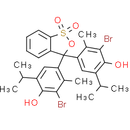Description
Bromothymol Blue is a pH indicator.
Product information
CAS Number: 76-59-5
Molecular Weight: 624.38
Formula: C27H28Br2O5S
Chemical Name: 3,3-bis[3-bromo-4-hydroxy-2-methyl-5-(propan-2-yl)phenyl]-3H-2,1λ⁶-benzoxathiole-1,1-dione
Smiles: CC1=C(C=C(C(C)C)C(O)=C1Br)C1(OS(=O)(=O)C2=CC=CC=C12)C1=CC(C(C)C)=C(O)C(Br)=C1C
InChiKey: NUHCTOLBWMJMLX-UHFFFAOYSA-N
InChi: InChI=1S/C27H28Br2O5S/c1-13(2)17-11-20(15(5)23(28)25(17)30)27(19-9-7-8-10-22(19)35(32,33)34-27)21-12-18(14(3)4)26(31)24(29)16(21)6/h7-14,30-31H,1-6H3
Technical Data
Appearance: Solid Power
Purity: ≥98% (or refer to the Certificate of Analysis)
Solubility: DMSO : 100 mg/mL (160.16 mM; Need ultrasonic). H2O : < 0.1 mg/mL (insoluble).
Shipping Condition: Shipped under ambient temperature as non-hazardous chemical or refer to Certificate of Analysis
Storage Condition: Dry, dark and -20 oC for 1 year or refer to the Certificate of Analysis.
Shelf Life: ≥12 months if stored properly.
Stock Solution Storage: 0 - 4 oC for 1 month or refer to the Certificate of Analysis.
Drug Formulation: To be determined
HS Tariff Code: 382200
How to use
In Vitro:
A first characterization and comparison is done by developing an easy and direct measurement method based on a pH indicator system using Bromothymol Blue (BTB) as the indicator and potassium phosphate as the buffer. A pH-shift assay is developed on the basis of BTB as the pH indicator and potassium phosphate as the buffer component. Three pH indicators are tested for the direct determination of 2- 2-keto-L-gulonic acid (2-KLG) production on a plate. The results show that Bromothymol Blue is superior to the other two indicators in terms of the obvious color change and a suitable pH range (blue to yellow at pH 6.5-7.5). Upon the addition of a Bromothymol Blue solution (0.1%, w/v) to an agar plate, zones surrounding colonies of K. vulgare 07 mutants change their color from blue to yellow because K. vulgare 07 mutants release 2-KLG on agar plates, thereby acidifying surrounding areas around colonies.
Products are for research use only. Not for human use.
Payment & Security
Your payment information is processed securely. We do not store credit card details nor have access to your credit card information.


